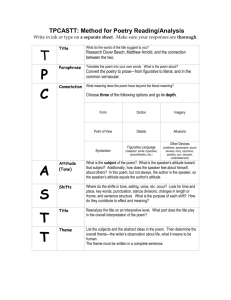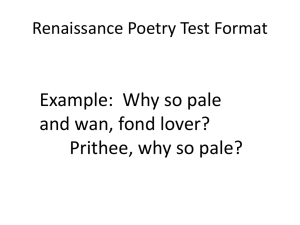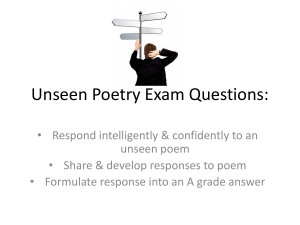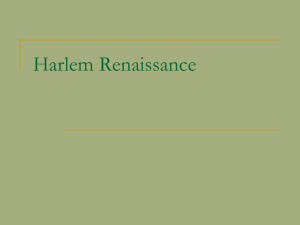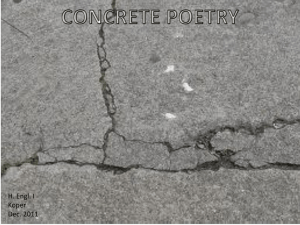Poetry Analysis Using TPCASTT
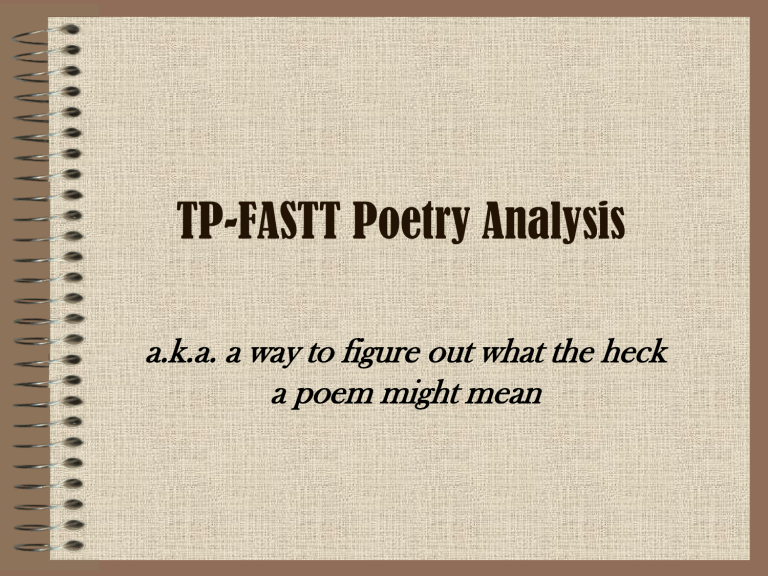
TP-FASTT Poetry Analysis a.k.a. a way to figure out what the heck a poem might mean
Getting Started…
• This is a process to help you organize your analysis of poetry.
• We have already learned the vocabulary that applies to poems--now it’s time to put it into practice!
TP-FASTT
TP-FASTT is an acronym that helps us analyze poems through seven simple steps
(each letter represents one step of analysis)
By looking at each smaller part individually and then at the poem altogether, it can help us make some sense of what the poem might be about!
Let’s try it together…
• T
• P
• F
• A
• S
• T
• T
TP-FASTT ‘American Hero’
T is for TITLE
•
Analyze the title first.
•
PREDICT what this poem will be about?
• Write down your predictions.
• We will reflect on the title again after we have read the poem; this simple step helps us think about what the poet may be implying in their titles.
READ THE POEM!!!!
American Hero
I have nothing to lose tonight.
All my men surround me, panting, as I spin the ball above our heads on my middle finger.
5
It’s a shimmering club light and I’m dancing, slick in my sweat.
Squinting, I aim at the hole fifty feet away. I let the tension go.
Shoot for the net. Choke it.
10 I never hear the ball slap the backboard. I slam it through the net. The crowd goes wild for our win. I scored thirty-two points this game
15 and they love me for it.
Everyone hollering is a friend tonight.
But there are towns, certain neighborhoods
20 where I’d be hard pressed to hear them cheer if I move on the block.
P is for PARAPHRASE
• Paraphrasing is putting something in your own words.
• After reading the poem, rewrite it in your own words .
• This may be three sentences or a page, depending on the particular poem.
F is for Figurative Language
• Analyze the figures of speech and sound effects of the poem.
• These are the poetry vocabulary we have already studied.
• These elements add to the meaning, so we need to make sure we understand what each one means!
A is for ATTITUDE
• Tone is the attitude of the speaker toward the subject of the poem.
WRITE DOWN
WHAT YOU
UNDERSTAND
THE AUTHOR’s
ATTITUDE (TONE)
TO BE!
Attitude/Tone Words
•
Angry
•
Sad
•
Afraid
•
Cold
•
Detached
•
Benevolent
• Dreamy
• Shocking
• Candid
• Proud
•
Giddy
•
Pitiful
•
Dramatic
•
Provocative
•
Sentimental
Upset
Urgent
Complimentary
Contemptuous
Silly
Joking
Condescending
Happy
Boring
Poignant
Sympathetic
Confused
Apologetic
Hollow
Childish
Humorous
Joyful
Peaceful
Horrific
Mocking
Sarcastic
Sweet
Objective
Nostalgic
Vexed
Vibrant
Zealous
Tired
Frivolous
Irrelevant
Bitter
S is for SHIFT
• If there is a change in…
– Time
– Tone
– Speaker
For example, does it start happy and end sad? Does time pass during the poem?
There may or may not be shifts..
T is for TITLE (again)
• At this time, you should reconsider the title.
• Were you right in your predictions?
•
What other meanings might the title have in light of your analysis?
• Next, the biggie….
T is for THEME
• Theme is the general insight into life conveyed by the author through his/her work.
• It does not make a judgment.
example: “Don’t do drugs” is not a theme.
• It merely states something that is true to life and the human condition.
How do I find the THEME ?
• Look at the other parts of TPCASTT.
• What insight are all of these working together to convey?
• What is the poet trying to say about their subject?

